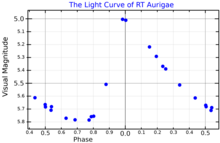RT Aurigae
Although its brightness is variable, it as consistently visible to the naked eye under good observing conditions.
RT Aurigae is an F to G type Classical Cepheid variable which varies from magnitude +5.00 to +5.82 with a period of 3.728309 days.
[7] The variability was discovered in 1905, by an English schoolmaster and amateur astronomer, Thomas Hinsley Astbury.
[13][14] It was quickly recognised as a member of the class of Cepheid variables, but their nature was not understood at that time.
Radial velocity changes were detected corresponding to the brightness variations, but the idea that these were caused by stellar pulsations and temperature changes was largely dismissed in favour of orbital motions of a binary star.
